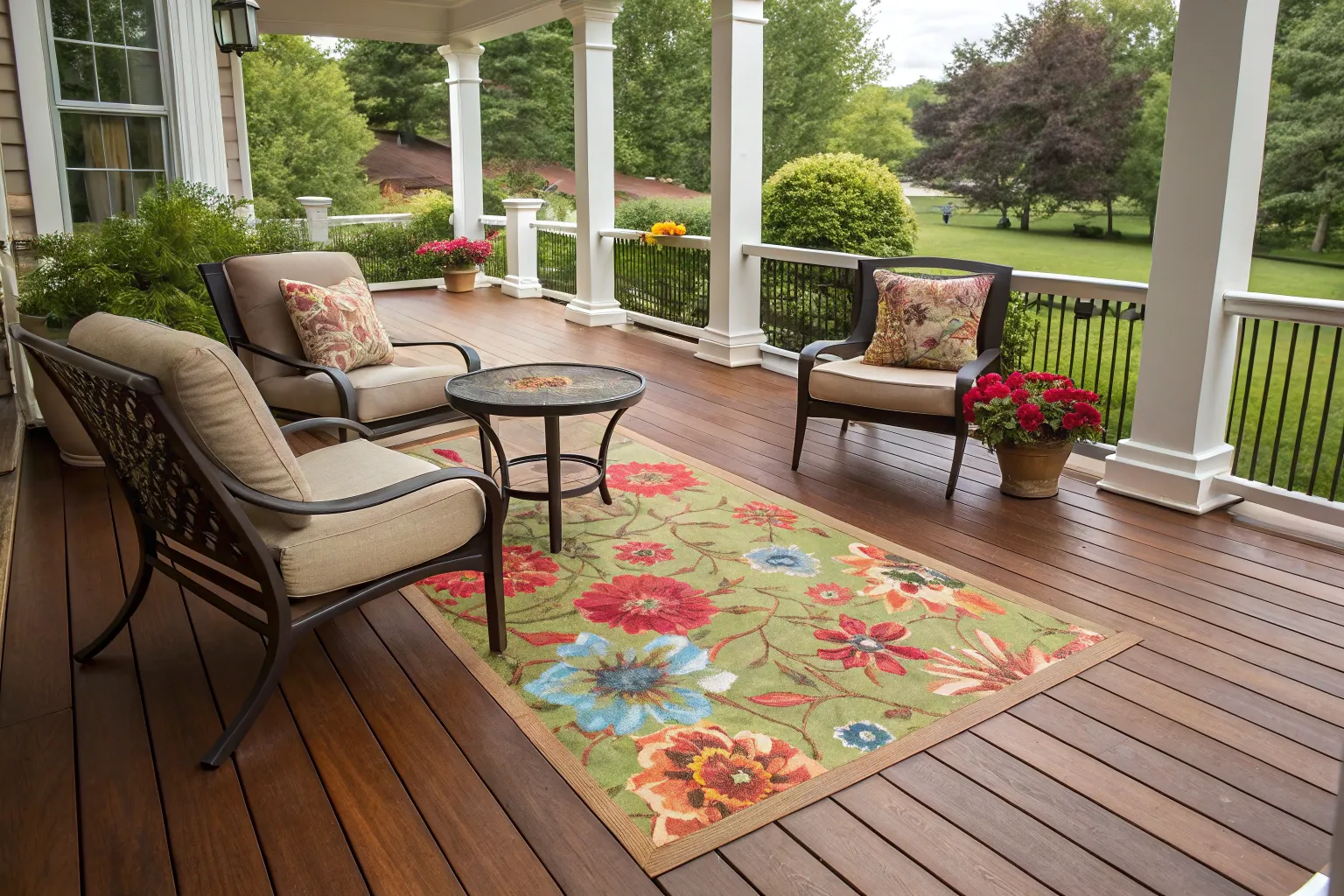Outdoor rugs have transformed from purely functional accessories to essential design elements that can completely redefine your outdoor living spaces. Whether you’re designing a cozy patio retreat or a sophisticated deck entertainment area, the right outdoor rug creates the foundation for exceptional outdoor living.
Understanding Outdoor Rug Materials

The durability and performance of your outdoor rug depend fundamentally on its material composition. Modern outdoor rugs are specifically engineered to handle the challenges of outdoor environments while maintaining their aesthetic appeal.
Polypropylene: The Performance Champion
Polypropylene stands as the gold standard for outdoor rugs, offering exceptional resistance to moisture, UV rays, and mildew. This synthetic fiber excels in wet conditions, making it ideal for poolside areas or regions with frequent rainfall. The material’s inherent water-resistant properties ensure quick drying and prevent the growth of mold and mildew that can plague other materials.
Recycled PET: Sustainable Excellence
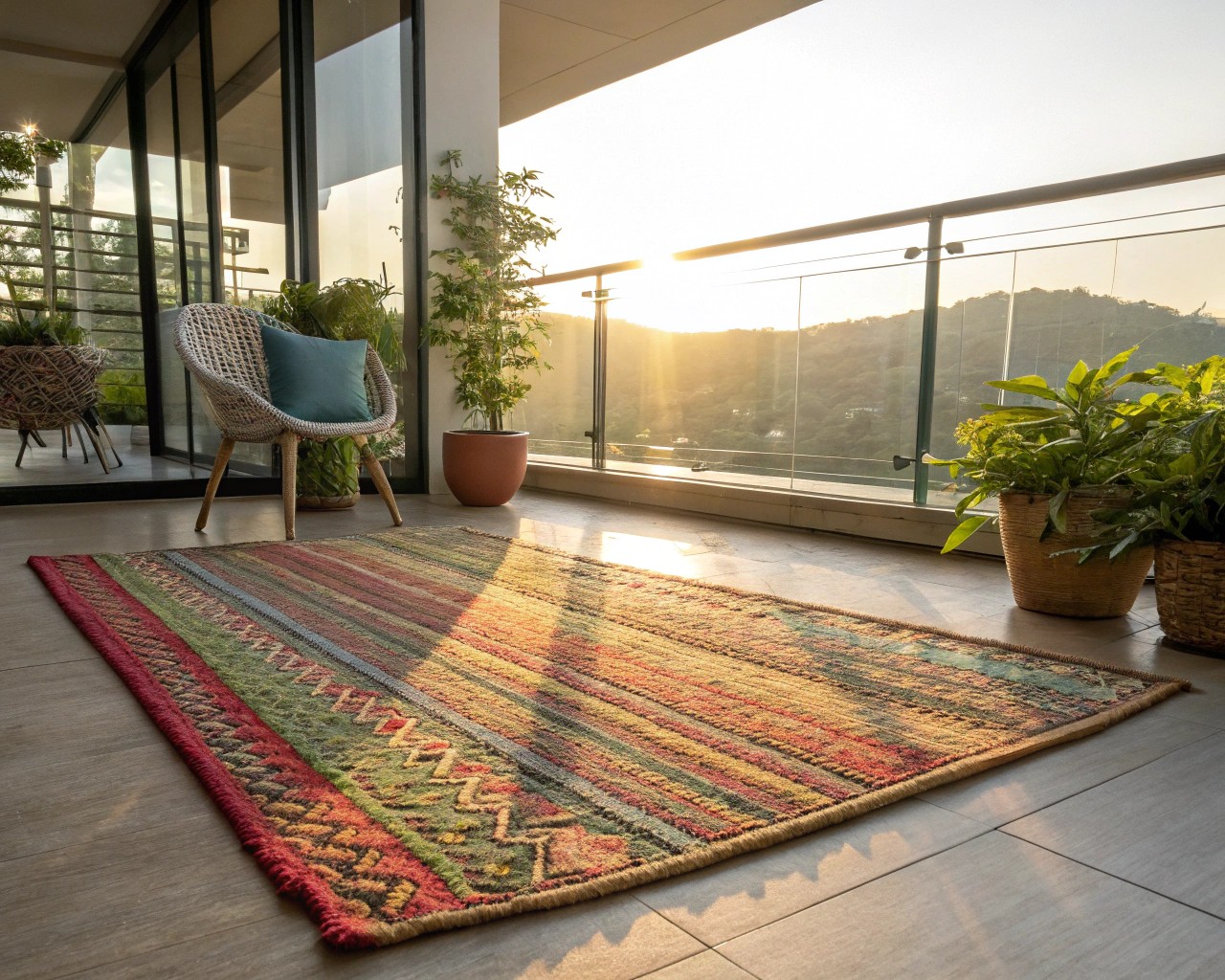
Recycled PET (polyethylene terephthalate), often made from plastic bottles, delivers impressive durability while supporting environmental sustainability. These rugs offer excellent color retention and fade resistance, making them particularly suitable for high-sun exposure areas. The recycled nature of this material doesn’t compromise performance—these rugs maintain their structural integrity through multiple seasons.
Polyester: Color Retention Specialist
Polyester outdoor rugs are renowned for their vibrant color retention, though they may trap slightly more moisture than polypropylene alternatives. This material works exceptionally well in covered outdoor areas where moisture exposure is limited but color vibrancy is paramount.
Solution-Dyed Acrylic: Premium Performance
For those seeking the highest performance standards, solution-dyed acrylic represents the premium tier of outdoor rug materials. The solution-dye process involves coloring fibers before they’re woven into the rug, ensuring deep color penetration throughout the material. This process creates exceptional UV resistance and fade prevention, making these rugs ideal for intense sun exposure.
Weather Resistance and Durability
Understanding the difference between water-resistant and waterproof outdoor rugs is crucial for making informed decisions. Most outdoor rugs are water-resistant rather than completely waterproof, meaning they repel moisture and dry quickly without entirely blocking water penetration.
UV Protection and Fade Resistance
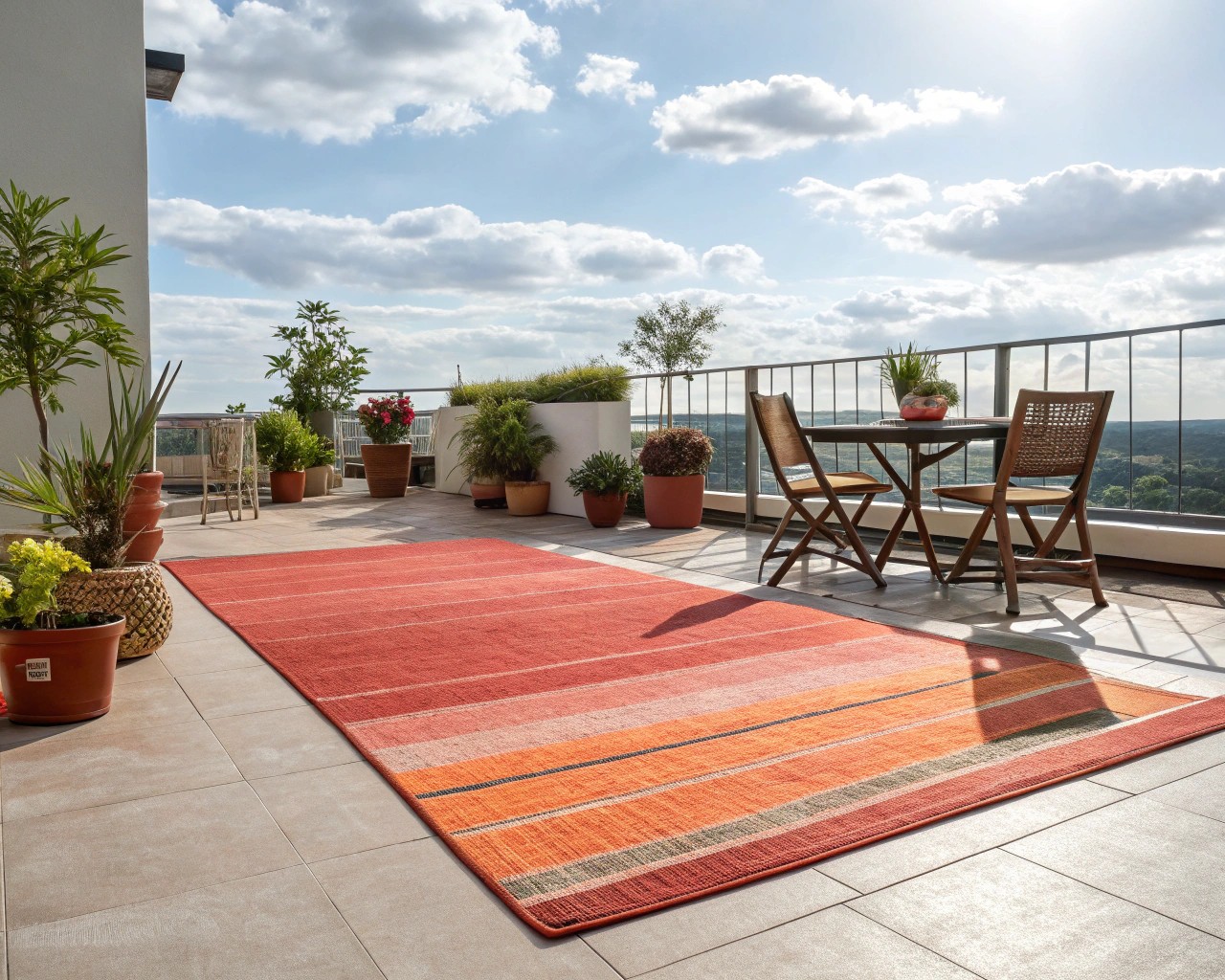
UV protection is non-negotiable for outdoor rugs, particularly in American climates with intense sunlight. Quality outdoor rugs incorporate UV stabilizers that prevent color fading and fiber degradation. Look for rugs specifically labeled as “UV-resistant” or “fade-resistant” to ensure longevity in sun-exposed areas.
Climate Considerations for American Homes
American climates vary dramatically, requiring different approaches to outdoor rug selection. Hot, dry climates demand UV-resistant materials like polypropylene, while humid regions benefit from quick-drying, mold-resistant options. Cold winter climates require rugs that can withstand freeze-thaw cycles without fiber damage.
Sizing and Placement Guidelines
Proper sizing transforms an outdoor rug from a decorative afterthought into a space-defining focal point. The key lies in understanding the relationship between your rug, furniture, and overall space dimensions.
Seating Areas
For outdoor seating arrangements, the rug should extend at least 18 inches beyond the furniture on all sides. This creates visual breathing room and ensures chairs remain on the rug when pulled out. For smaller spaces, a minimum of 12 inches is acceptable, but 18 inches provides optimal proportion.
| Furniture Configuration | Recommended Rug Size | Purpose |
|---|---|---|
| Small patio conversation set | 5′ x 8′ | Intimate seating for 2-4 people |
| Sectional with coffee table | 7′ x 9′ | Defines larger seating areas |
| Large outdoor furniture collection | 9′ x 12′ | Anchors expansive entertaining spaces |
Dining Areas

Outdoor dining setups require careful consideration of chair movement. The rug should extend 24 inches beyond the table on all sides to accommodate chair sliding without falling off the rug edge. This spacing also protects deck surfaces from furniture scratching.
Small Spaces and Balconies
For compact outdoor areas like balconies or small patios, leave approximately 12 inches of exposed flooring around the rug perimeter. This prevents the space from feeling cluttered while maintaining visual balance.
Color Schemes and Design Trends
Contemporary outdoor rug design reflects a sophisticated understanding of how textiles can enhance outdoor environments. The most successful outdoor spaces coordinate their rug selection with both architectural elements and natural surroundings.
Trending Color Palettes
Sage Green: This plant-inspired hue creates seamless connections with garden environments while providing calming, natural appeal.
Terracotta: Warm Mediterranean tones add richness and complement stone or brick architectural elements.
Sand Beige: Neutral tones provide versatile foundations that work with changing seasonal accessories.
Monochromatic Schemes: Single-color palettes in varying shades create sophisticated, cohesive looks that never compete with furniture or plantings.
Pattern Selection
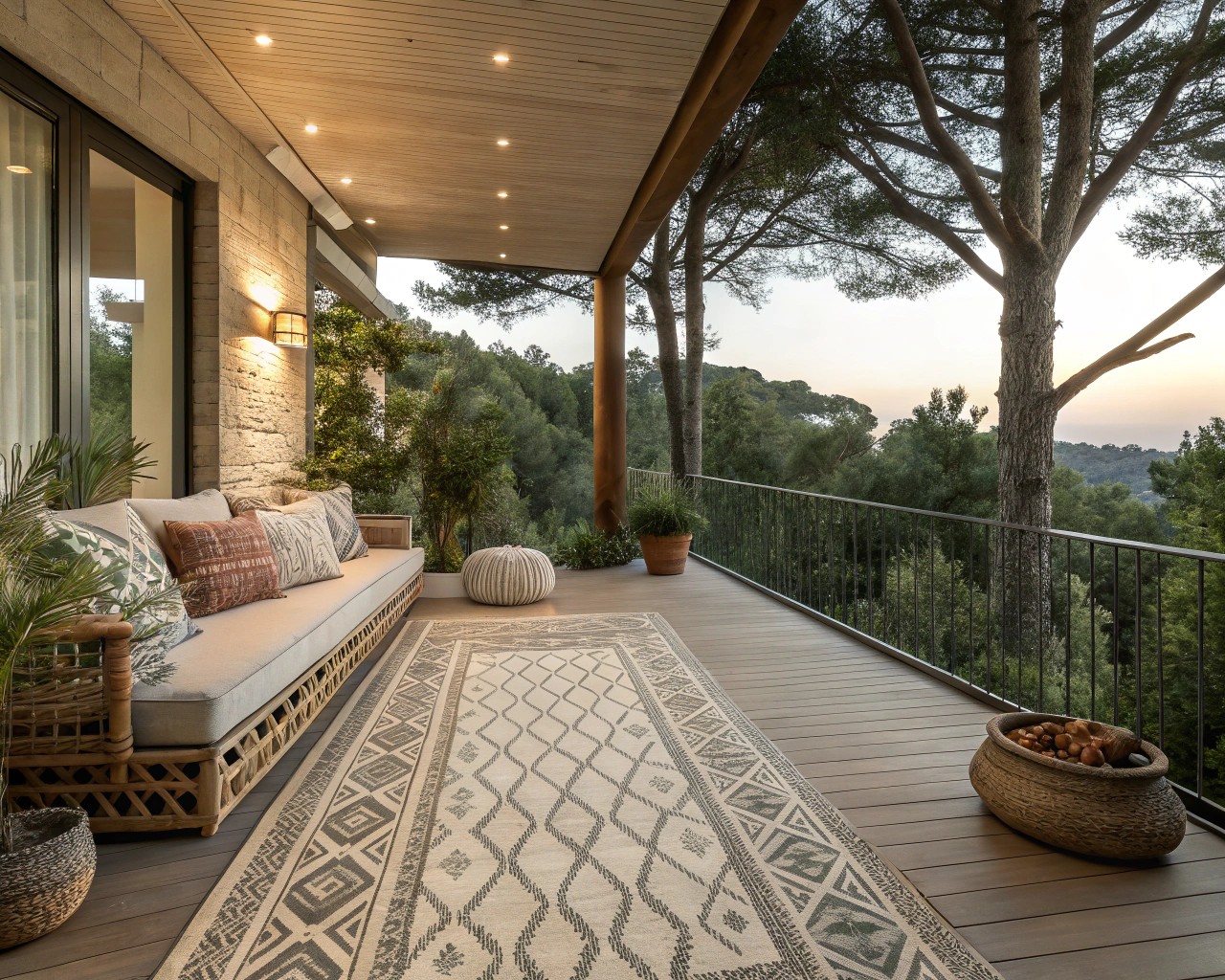
Geometric Patterns: Bold geometric designs bring modern energy to outdoor spaces while hiding minor imperfections from weather exposure. These patterns work particularly well in contemporary settings with clean architectural lines.
Botanical Motifs: Nature-inspired designs featuring leaves, flowers, and organic forms create harmony with garden settings. These patterns work especially well in traditional or cottage-style outdoor spaces.
Stripe Patterns: Classic stripes provide timeless appeal and can visually expand smaller spaces when oriented appropriately.
Styling Techniques and Zone Definition
I’ve observed that successful outdoor rug styling goes beyond simply placing a rug under furniture. The most effective approach involves using rugs to create distinct functional zones within larger outdoor spaces.
Creating Functional Zones
Outdoor rugs excel at defining different activity areas without permanent structural changes. Use a dining rug to separate eating areas from lounging spaces, or place a conversation rug to create intimate seating zones within larger patios.
Layering Techniques
Layering outdoor rugs adds depth and visual interest while providing practical benefits. Start with a larger, neutral base rug and add a smaller, patterned accent rug on top. This technique allows for seasonal updates without replacing the entire foundation.
Successful Layering Combinations:
- Jute base with geometric accent pattern
- Neutral striped foundation with botanical topper
- Solid color base with contrasting texture overlay
Furniture Arrangement
The relationship between rugs and furniture determines the overall success of outdoor styling. For larger spaces, float furniture in the center of the rug, ensuring all pieces remain fully on the rug surface. In smaller areas, position front furniture legs at the rug edge while keeping back legs on the surface.
Maintenance and Care
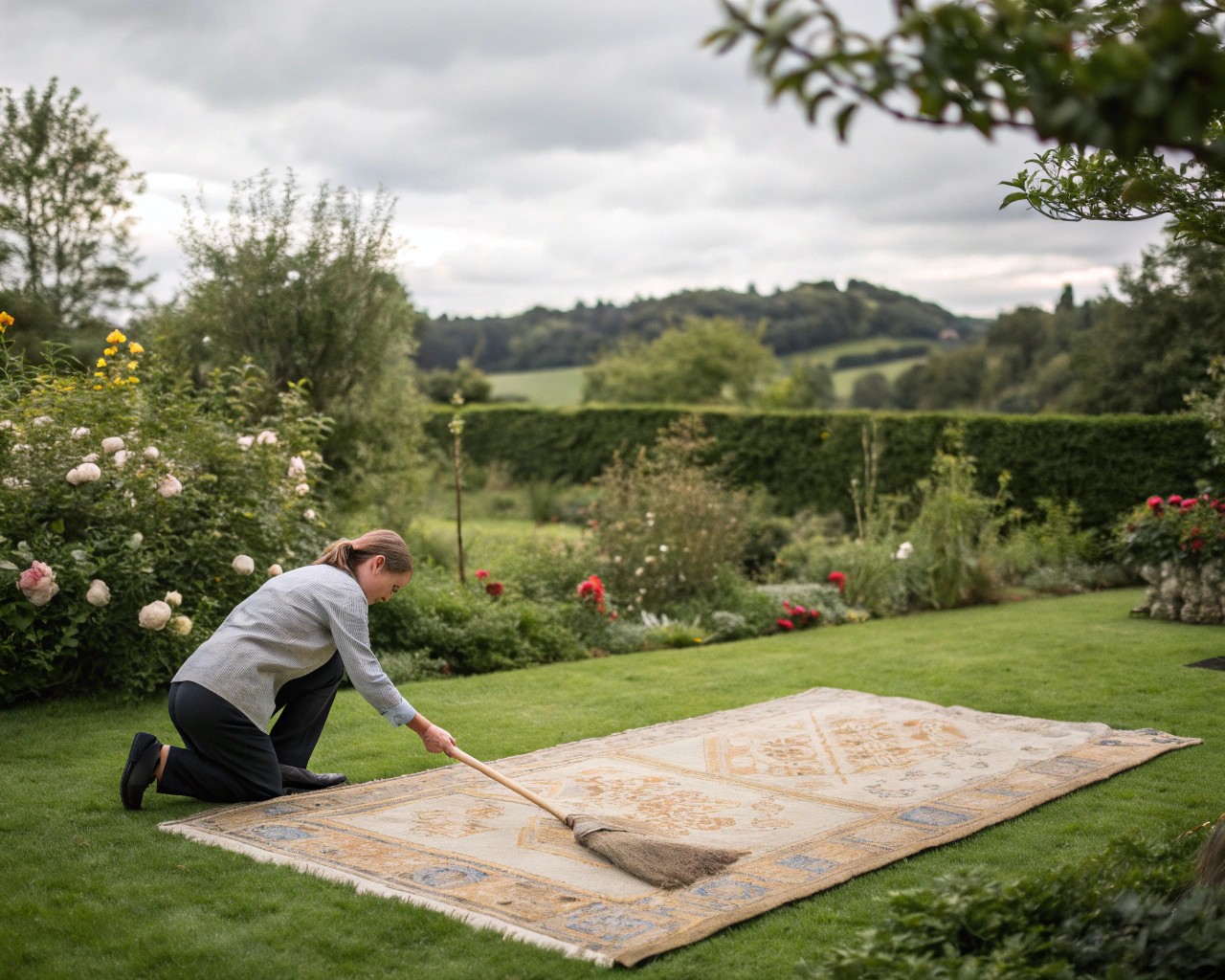
Proper maintenance extends outdoor rug life significantly while preserving appearance and performance. The key lies in establishing regular cleaning routines and understanding material-specific care requirements.
Regular Cleaning Protocols
Weekly Maintenance: Shake out loose dirt and debris, then vacuum both sides of the rug to remove embedded particles. For plastic or synthetic materials, consider using a wet/dry vacuum for deeper cleaning.
Monthly Deep Cleaning: Hose down the rug with clean water, apply mild dish soap solution, and scrub gently with a soft-bristled brush. Rinse thoroughly to remove all soap residue, which can attract dirt if left behind.
Stain Treatment: Address spills immediately by blotting (never rubbing) with a clean cloth. For stubborn stains, create a paste with baking soda and water, apply to the affected area, and allow to sit before gentle scrubbing.
Storage and Seasonal Care
Winter Storage: Clean and dry rugs thoroughly before storage to prevent mold and mildew growth. Roll (never fold) rugs to prevent permanent creases, and store in cool, dry locations with good air circulation.
Off-Season Protection: For rugs left outside year-round, brush off snow regularly and ensure proper drainage underneath. Consider using breathable covers during extreme weather periods.
Safety Considerations
Safety should never be compromised for style in outdoor rug selection. Modern outdoor rugs incorporate various safety features that prevent accidents while maintaining aesthetic appeal.
Non-Slip Technology
Non-slip backing materials grip surface securely, preventing rug movement that could cause trips and falls. Look for rugs with integrated non-slip backing or plan to use separate rug pads designed for outdoor use.
Secure Anchoring Methods
Furniture Weighting: Position heavy outdoor furniture strategically to anchor rug corners and edges.
Rug Grippers: Adhesive strips or gripper pads create secure bonds with smooth surfaces like concrete or composite decking.
Weighted Corners: Use decorative elements like planters or garden sculptures to secure rug corners while enhancing the overall design.
Climate-Specific Considerations
American homes span diverse climate zones, each presenting unique challenges for outdoor rug selection and maintenance. Understanding these regional differences ensures optimal performance and longevity.
Hot, Dry Climates
In desert and southwestern regions, prioritize UV-resistant materials like polypropylene or solution-dyed acrylic. These climates require rugs with exceptional fade resistance and materials that won’t become brittle under intense sun exposure.
Humid, Coastal Areas
Coastal and southeastern climates demand quick-drying materials with superior mold and mildew resistance. Polypropylene and recycled PET perform exceptionally well in these conditions, maintaining their integrity despite high humidity levels.
Cold Winter Regions
Northern climates require rugs that can withstand freeze-thaw cycles without fiber damage. Synthetic materials generally outperform natural fibers in these conditions, maintaining flexibility and structural integrity through temperature fluctuations.
Professional Installation and Styling Tips
From my experience with outdoor design projects, the difference between amateur and professional-looking outdoor rug installations lies in attention to detail and understanding of spatial relationships.
Professional Placement Techniques
Create visual balance by ensuring the rug extends equally on all sides of central furniture pieces. For asymmetrical arrangements, maintain consistent spacing relationships to prevent the space from feeling unbalanced.
Integration with Landscape Elements
The most successful outdoor rug installations coordinate with existing landscape features. Consider how the rug’s colors and patterns interact with plantings, hardscaping, and architectural elements. This integration creates cohesive outdoor environments that feel intentionally designed rather than merely decorated.
Lighting Considerations
Outdoor rugs interact with both natural and artificial lighting throughout the day. Consider how morning sun, afternoon shadows, and evening lighting will affect the rug’s appearance and choose colors and patterns accordingly.
Outdoor rugs represent one of the most impactful investments you can make in your outdoor living spaces. By understanding materials, proper sizing, maintenance requirements, and styling techniques, you can create outdoor environments that rival the comfort and sophistication of indoor rooms. The key lies in viewing outdoor rugs not as afterthoughts, but as foundational elements that define, enhance, and elevate your outdoor living experience.

